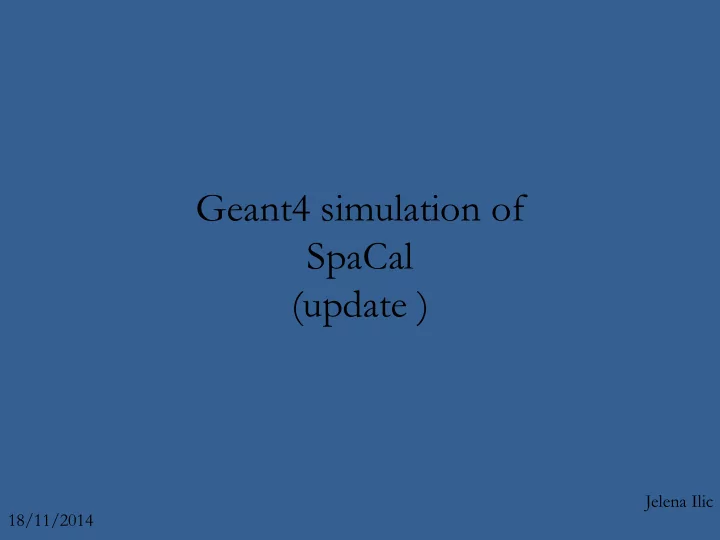

Geant4 simulation of SpaCal (update ) Jelena Ilic 18/11/2014
Analysis of scint.photons
Geometry 1) Calo block: 5 x 5 x 10 cm 2) 100 µ m air gap between W and quartz 3) 200 µ m Al “mirror” at the front of calo block 5 ¡cm ¡ 5 ¡cm ¡ L ¡= ¡10 ¡cm ¡ y ¡ x ¡ z ¡
Scintillation photons NOTE • In the earlier talks I was giving the number of scint. photons LEAVING the calo block. • But what we actually need is the number of scint. photons that arrive at the back of the calo block. • How many of them will leave the block depends on the material surrounding the calo block, and in my simulations it is the AIR. • Refractive index of the air is 1, refractive index of quartz (fused silica) is 1.47 and of our scintillator is 1.57. That means that the critical angle for the total internal reflection is around 42 o θ c = arcsin(n air /n 1 )~42 o i.e. more than 50% of all scint. photons arriving at the back of the calo block will be totally reflected.
Scintillation photons • The results on slide 5 show what is happening with scintill. photons for 3 different geometries. I used the following notation: 1. noAIR: no air gap between quartz and W; no Al mirror 2. AIR: 100 µ m gap between quartz tubes and W; no Al mirror 3. AIR & MIRROR: 100 µ m gap between quartz tubes and W and 200 µ m thick Al mirror at the front of the calo block ALSO: eDep - energy deposited in the scintillator • Scint Produced - total number of scint. photons produced • ScintOut - the total number of scint. photons that arrive at the front and the back • of the calo block ScintOutP - the number of scint. photons that arrive at the back of the calo block • Bulk Apsorp - Bulk absorption of scintill. photons in material (i.e. in quartz and • scintillator itself) Absorbed @ Boundary -number of scintill. photons absorbed at optical boundary • (i.e. boundary with W, since they cannot be absorbed at dielectric_dielectric boundaries)
Scintillation photons For the result below I used 20 GeV electrons (1000 events) The impact point is the centre of the block (Tungsten) ¡ • If we do not have an air gap between quartz tubes and tungsten around 6% of all produced scint. photons will reach the end of calo block. • leaving a small air gap we get 19% off all produced photons at the end of the block • Adding a thin Al mirror at the front that number rises to 35% of all scint.photons produced. • How many of them will arrive at pmt photodiode of course depends on the refractive indices of glue/glass of the pmt we are going to use... • In all 3 cases energy deposited in the scintillator is similar
Analysis of X 0
X 0 • X 0 is mean distance over which e - loses all but 1/e of its energy by bremsstrahlung Depends on position of our calo-block in regard to the beam • Case 1) electr electron sour on source: ce: Point distance: distance: 3m 3m ¡ ~1 ¡cm ¡ dir direction: ection: Cone angular spr angular spread: ead: 3.2 mrad calo calo-block: -block: 20x20x10 cm pitch: pitch: 1.2 mm tube tube φ : 0.8 mm AIR+ MIRROR 1000 events • 159 events (16%) electon didn’t produce shower; average energy deposited in scintillator 10 MeV • remaining 841 event-> X0=1.5 cm; average energy deposited in the scintillator 120 MeV ¡
with pitch=1.2 mm; φ holes =0.41 mm 33% holes 77% tungsten X 0 mm
X 0 Case 2) electr electron sour on source: ce: Plain sour source shape: ce shape: Circle source sour ce radious radious: 0.5 cm distance: distance: 20 cm e - - dir direction: ection: (0, 3deg, 0) calo calo-block: -block: 10x10x10 cm pitch: pitch: 1.2 mm tube tube φ : 0.8 mm AIR+MIRROR Andrea ¡ X0 ¡(cm) ¡ eDep ¡(MeV) ¡ Scint.Produced ¡ x10 3 ¡ 0.7 ¡ 141 ¡ 1622 ¡ Jelena ¡ ¡ pitch ¡=2mm, ¡X 0 ¡ = ¡0.38 ¡cm ¡ (Tungsten ¡X 0 ¡=0.36 ¡cm) ¡ ¡
Recommend
More recommend